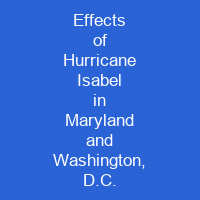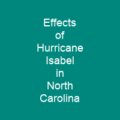Tropical Storm Isabel made landfall on the Outer Banks of North Carolina on September 18. It produced a storm surge of 8 feet on the Eastern shore of Maryland. Washington, D. C. sustained moderate damage, primarily from the winds. Throughout Maryland and Washington, damage totaled about USD 945 million.
About Effects of Hurricane Isabel in Maryland and Washington, D.C. in brief

In Washington, preparations began several days prior to the arrival of the hurricane, including placing sandbags in flood-prone areas. In most areas, the public response to the evacuation orders was normal to fast, with traffic during the evacuation described as light to normal. The most significant problems experienced during the evacuations were downed trees, inadequate signage, flooded roads, or stalled cars. In Maryland, about 20% of those who participated in an evacuation survey said they had concerns about being caught on roadways while trying to evacuate as the storm arrived, with similar numbers expressing concern about being able to return to their homes if they evacuated. By four days before the hurricane made landfall, most computer models predicted Isabel to make landfall between North Carolina and New Jersey. By the time the hurricane passed through the area, the city was largely empty and streets across the city were largely empty by the time it made landfall. The National Hurricane Center issued a hurricane watch for the southern region of the Maryland coastline on the Chesapeake Bay on September 16, about two days before Isabel struck land. The hurricane watch was upgraded to a tropical storm warning by about 24 hours before landfall. It quickly weakened over land and became extratropical over western Pennsylvania the next day. It produced a storm surge at 8 feet on the Eastern shore of Maryland, and produced a peaking storm surge of 8 feet at ChesapeakeBay on September 17. The storm surge was the largest storm surge in the history of Maryland.
You want to know more about Effects of Hurricane Isabel in Maryland and Washington, D.C.?
This page is based on the article Effects of Hurricane Isabel in Maryland and Washington, D.C. published in Wikipedia (as of Dec. 05, 2020) and was automatically summarized using artificial intelligence.







